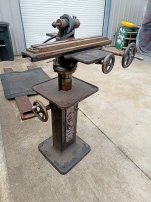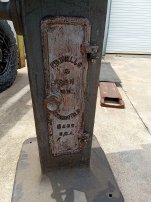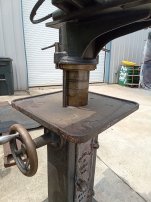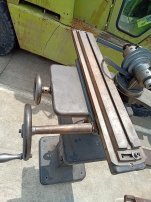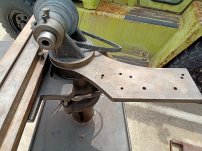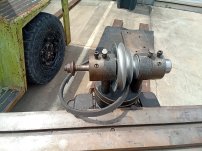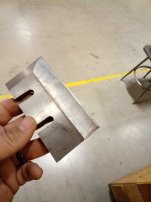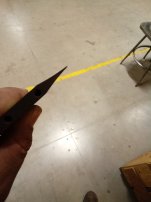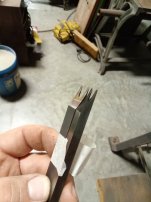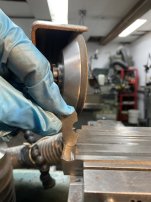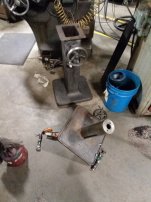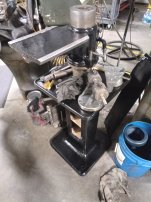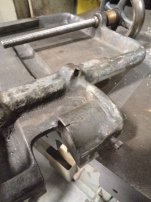M.B. Naegle
Diamond
- Joined
- Feb 7, 2011
- Location
- Conroe, TX USA
I've posted before that one of my ideas/potential projects is to locate or make a machine capable of 'hollow grinding' straight edge blades. Our business deals with lots of machinery with single and double bevel fixed blades used in Leatherworking, and most often they are straight beveled blades that are made by milling to shape and surface grinding before and after heat treating, followed by hand finishing the final edge. Often we are asked to re-shapen older used blades which are not a challenge, but often have been hand ground to odd bevels with uneven material removed, but some time on the surface grinder can correct it. Occasionally we run into 'hollow ground' blades however, which have a radiused bevel perpendicular to the straight edge. These can be hand sharpened simply, but if the bevel has become misshapen (which is often when they are sent to us), there's no simple way to grind it back in. The reason is that the radius of a surface grinding stone wheel is often too large and always changing diameter/radius. You can use a CBN wheel of the desired diameter, but the cross travel on our surface grinders is too short for some blades, as the blade has to be set perpendicular to the wheel. The other caveat is that the re-sharpening service is no place to make money. Often a new blade while expensive, is cheaper than paying machine shop time for skilled operators with expensive diamond chip wheels to fix a blade. So all this has lead me to wanting a machine for our shop that doesn't take a whole lot of skill, space, or precision tools to use, and uses cheap expendables. One of the hollow ground blades we service has a dedicated sharpening machine that works great, but uses 4" diameter CBN wheels that seem to always be wearing out. They're not an off-the shelf wheel and are not cheap. We found a supplier of Chinese wheels, and they barely last 3 or 4 sets of blades before the diamond coating starts to smooth. We used to have a company that would recoat the wheels, but they closed and other companies quotes have been cost-prohibitive.
So with that situation, my solution is to find and utilize an old tool and cutter grinder as the machine because it offers the necessary geometric adjustments and movements, they can often be found cheap because they are missing all the tooling, and these sharpening jobs would require their own tooling anyway which should be simple to make. The other reason I'm looking at those is that often the older ones are much smaller format while still having plenty of work envelope for this job, and they are very simple mechanically with all manual movements. I have an old Cincinnati that would work, but it still needs lots of help and I'm looking forward to setting it up as a typical T&C grinder. Most of these small T&C grinders are or were overhead belt drive, which I'm all for but my line-shaft shop is still a long ways away so for this job I would need an independently powered machine.
The next part of the equation is the expendables, and for that I want to set up a belt sander as the grinding head. Belts are cheap and as many knife-makers find the belt helps to get heat away from the grind. The diameter can be set by whatever the bottom wheel is, with the grinding happening at the radius, not along the flat portion of the belt. These hollow grinding jobs don't require exact precision movements, but are more about material removal that is linearly consistent, so I think a sanding belt would be fine for it.
So I've been mulling this potential job/project over for awhile, and then this machine becomes available locally at a decent price. It's an F.E. Wells & Son, which seem to have mainly made lathes and pipe threading machinery, but also dabbled in milling machines and their cutter grinders. Google pulls up a couple other examples of their T&C grinders, but they don't seem as common as Cincinnati, K.O. Lee, or the others. The grinding head has a spindle and what I think is a motor mounting plate? It's cast, but looks different than the catalog images I've seen, so I think this is a later model machine. The table and all the movements look complete, so If I can sort out a bolt on belt grinding wheel, tensioner, and motor, I'm in business. I don't want to make permanent modifications to the machine and would love to find more info about it. There's a catalog on Vintage Machinery that has a lot of good information and pictures, so perhaps once my Cincinnati is complete and working again, I can get into fabricating replacement tooling for this grinder as well.
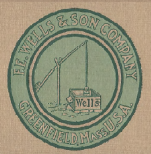
Here's a link to the catalog on VM - F.E. Wells Catalog Pages 28-51 cover their cutter grinder machines.

This company started around 1900 and were around under this name at least till 1917 when Greenfield Tap bought them out and started discontinuing their lines, name included.
My machine doesn't look to have much rust or damages, but could use a good cleaning, so I want to start there, taking it apart and making sure everything is good, and probably give it a fresh coat of black while I'm at it.
So with that situation, my solution is to find and utilize an old tool and cutter grinder as the machine because it offers the necessary geometric adjustments and movements, they can often be found cheap because they are missing all the tooling, and these sharpening jobs would require their own tooling anyway which should be simple to make. The other reason I'm looking at those is that often the older ones are much smaller format while still having plenty of work envelope for this job, and they are very simple mechanically with all manual movements. I have an old Cincinnati that would work, but it still needs lots of help and I'm looking forward to setting it up as a typical T&C grinder. Most of these small T&C grinders are or were overhead belt drive, which I'm all for but my line-shaft shop is still a long ways away so for this job I would need an independently powered machine.
The next part of the equation is the expendables, and for that I want to set up a belt sander as the grinding head. Belts are cheap and as many knife-makers find the belt helps to get heat away from the grind. The diameter can be set by whatever the bottom wheel is, with the grinding happening at the radius, not along the flat portion of the belt. These hollow grinding jobs don't require exact precision movements, but are more about material removal that is linearly consistent, so I think a sanding belt would be fine for it.
So I've been mulling this potential job/project over for awhile, and then this machine becomes available locally at a decent price. It's an F.E. Wells & Son, which seem to have mainly made lathes and pipe threading machinery, but also dabbled in milling machines and their cutter grinders. Google pulls up a couple other examples of their T&C grinders, but they don't seem as common as Cincinnati, K.O. Lee, or the others. The grinding head has a spindle and what I think is a motor mounting plate? It's cast, but looks different than the catalog images I've seen, so I think this is a later model machine. The table and all the movements look complete, so If I can sort out a bolt on belt grinding wheel, tensioner, and motor, I'm in business. I don't want to make permanent modifications to the machine and would love to find more info about it. There's a catalog on Vintage Machinery that has a lot of good information and pictures, so perhaps once my Cincinnati is complete and working again, I can get into fabricating replacement tooling for this grinder as well.

Here's a link to the catalog on VM - F.E. Wells Catalog Pages 28-51 cover their cutter grinder machines.

This company started around 1900 and were around under this name at least till 1917 when Greenfield Tap bought them out and started discontinuing their lines, name included.
My machine doesn't look to have much rust or damages, but could use a good cleaning, so I want to start there, taking it apart and making sure everything is good, and probably give it a fresh coat of black while I'm at it.


